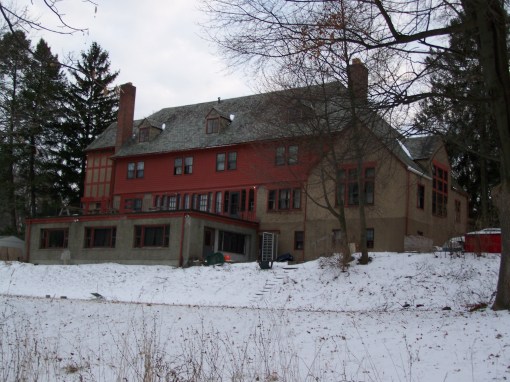After a lull in new development proposals in the city of gorges, something new has come to the table. Down in big box land, another hotel seeks to join the ten-year old Hampton Inn (66 rooms) and the recently-completed Fairfield Inn (106 rooms). According to Jason over at Ithaca Builds, the proposed “All Suites Hotel” at 371 Elmira Road calls for a 4-story, 54′ tall, 11,769 sq ft hotel with approximately 76 rooms, proposed for the site of a vacant office building and an auto body shop (both of which would be demolished). Looking at the aerial below, its proximity to the new Fairfield (upper right) is quite clear. Planning board agenda here, map of site here, site plans here, elevations/renderings here.
Although no brand is stated in the proposal, I suspect it might be a part of the Holiday Inn Express brand owned by Intercontinental Hotels Group. For one, the hotel is in the 60-80 room range as recently-built HIE hotels (see the recently-opened 74-room Holiday Inn Express in Cortland for example). Reason number two, Intercontinental Hotels Group will lose its Ithaca presence once the license with the downtown property expires in January, and the Ithaca hotel market is generally strong enough that they might wish to maintain a slice of the hospitality market.
Although it’s pretty standard chain hotel fare, architectural work is being handled by Buffalo-based Silvestri Architects. Additional work will be undertaken by Optima Design and Engineering, also out of Buffalo (no surprise, the developer’s LLC also has a Buffalo address). Both organizations have previous experience with chain hotel construction and design.
Apart from that, other proposals in the city include a small amount of infill at the Statler Hotel, a two-family home on West Hill, and a 10,384 sq ft commercial building on Cherry Street. Ithaca Builds notes the Cherry Street proposal is a Crossfit Gym, to be housed in a rather industrial-looking 1-story structure with a pitched roof.
In other news, Cornell has beaten a proverbial hornet’s nest with a stick. The Cornell Sun published an article last Friday that the men’s lacrosse coach would be dismissed from his position. The decision is widely suspected to be related to the suspension of the Lacrosse team from fall exhibition games after a hazing incident where allegedly freshman were forced to chug beer by senior team members. Unlike fraternities, where one merely has to wait before some chapter does something stupid, the lacrosse team is respected by its peers and a moneymaker for the university, so this seems unreasonably harsh. Given the commentary on the article, Cornell’s heavy-handed approach appears to have its share of critics. As a personal opinion, I feel the lacrosse team is being made an example of, to scare the other teams into playing nice. In the long run, I don’t think there will be much uproar until the university starts to go after large student groups outside the Greek system and athletics. The more students who feel Cornell breathing down their necks, the more they’ll raise a hue and cry.
UPDATE 1/30/14: And it is in fact a Holiday Inn Express. I’m giving myself a gold star.












